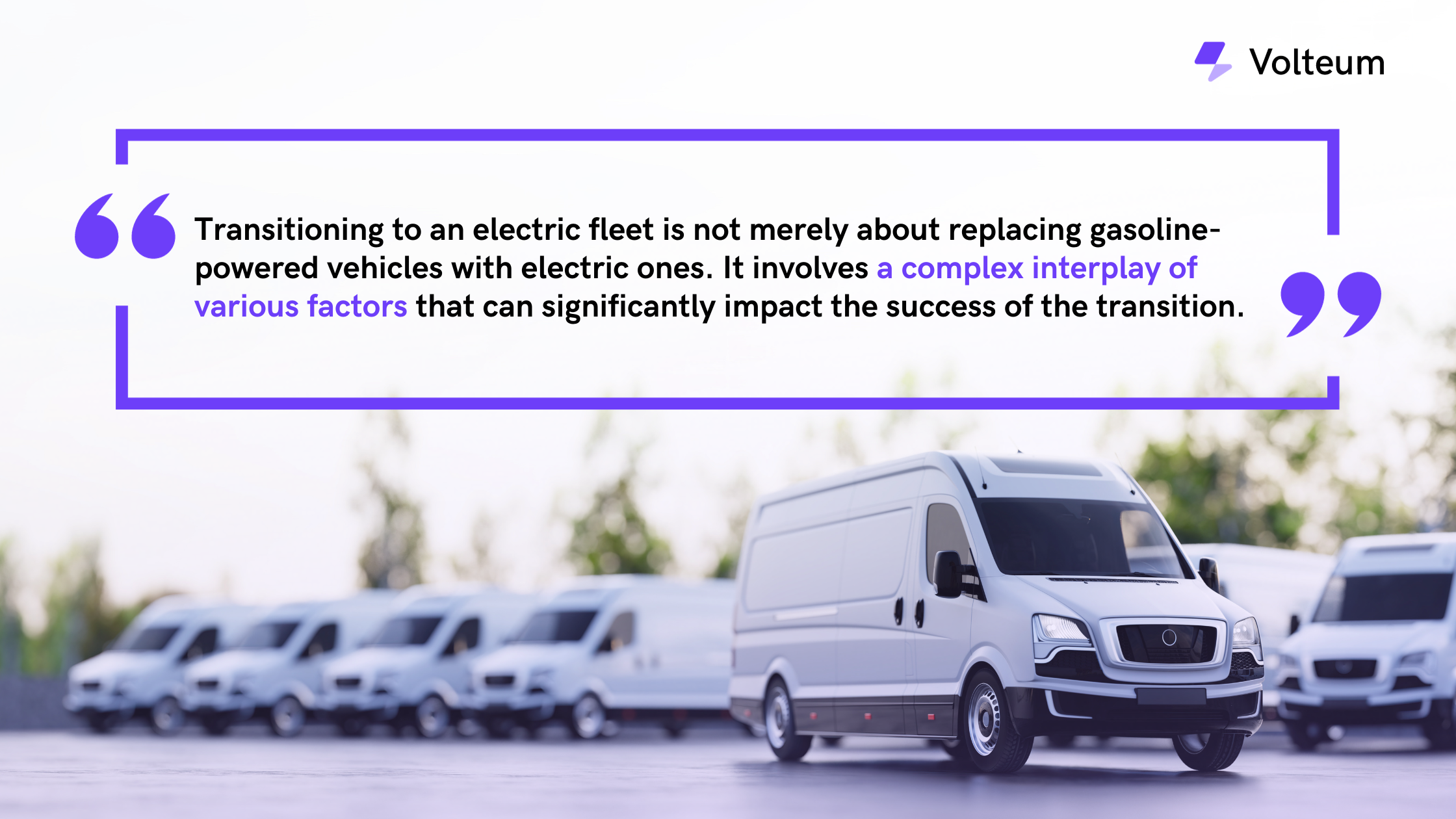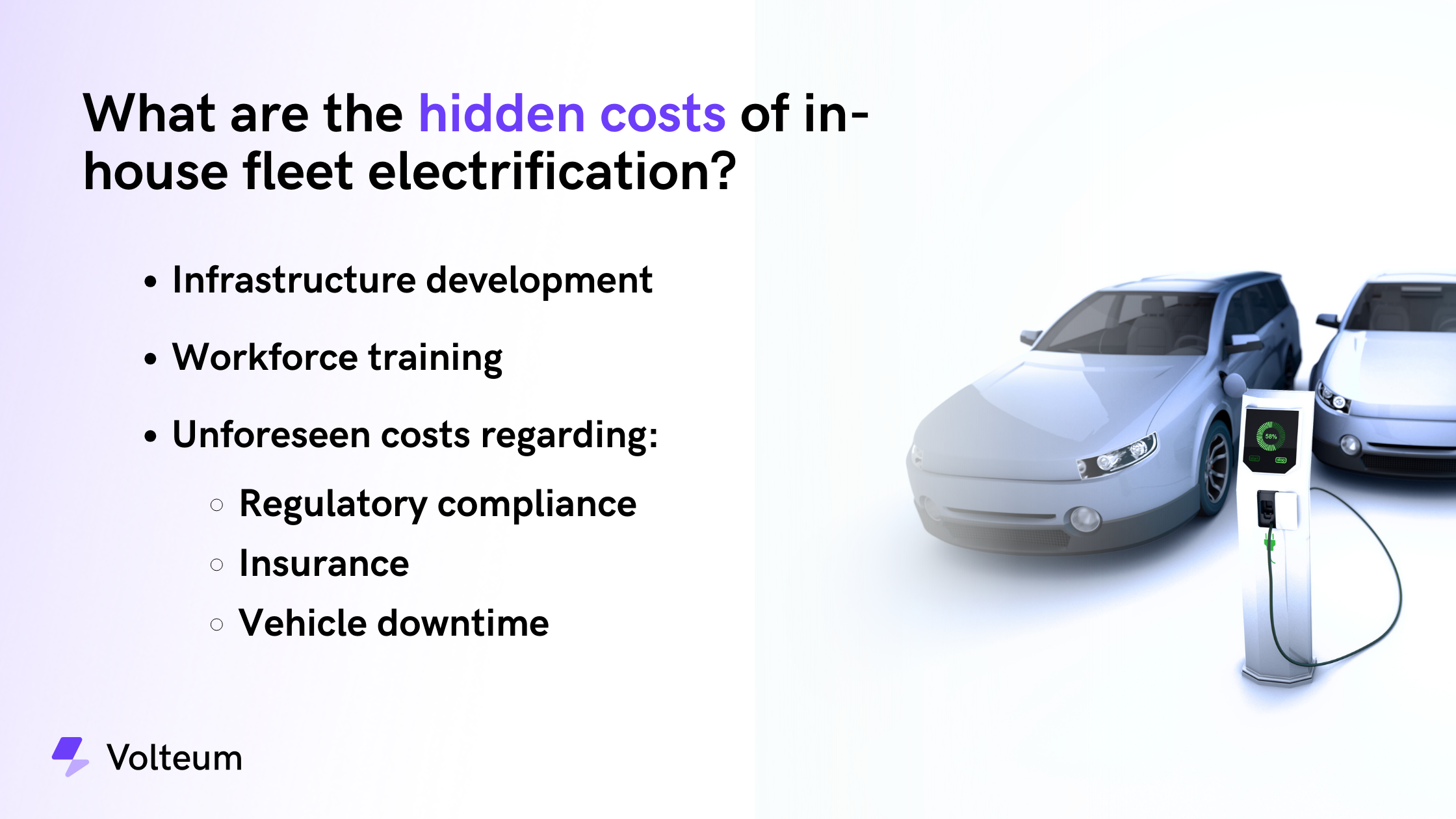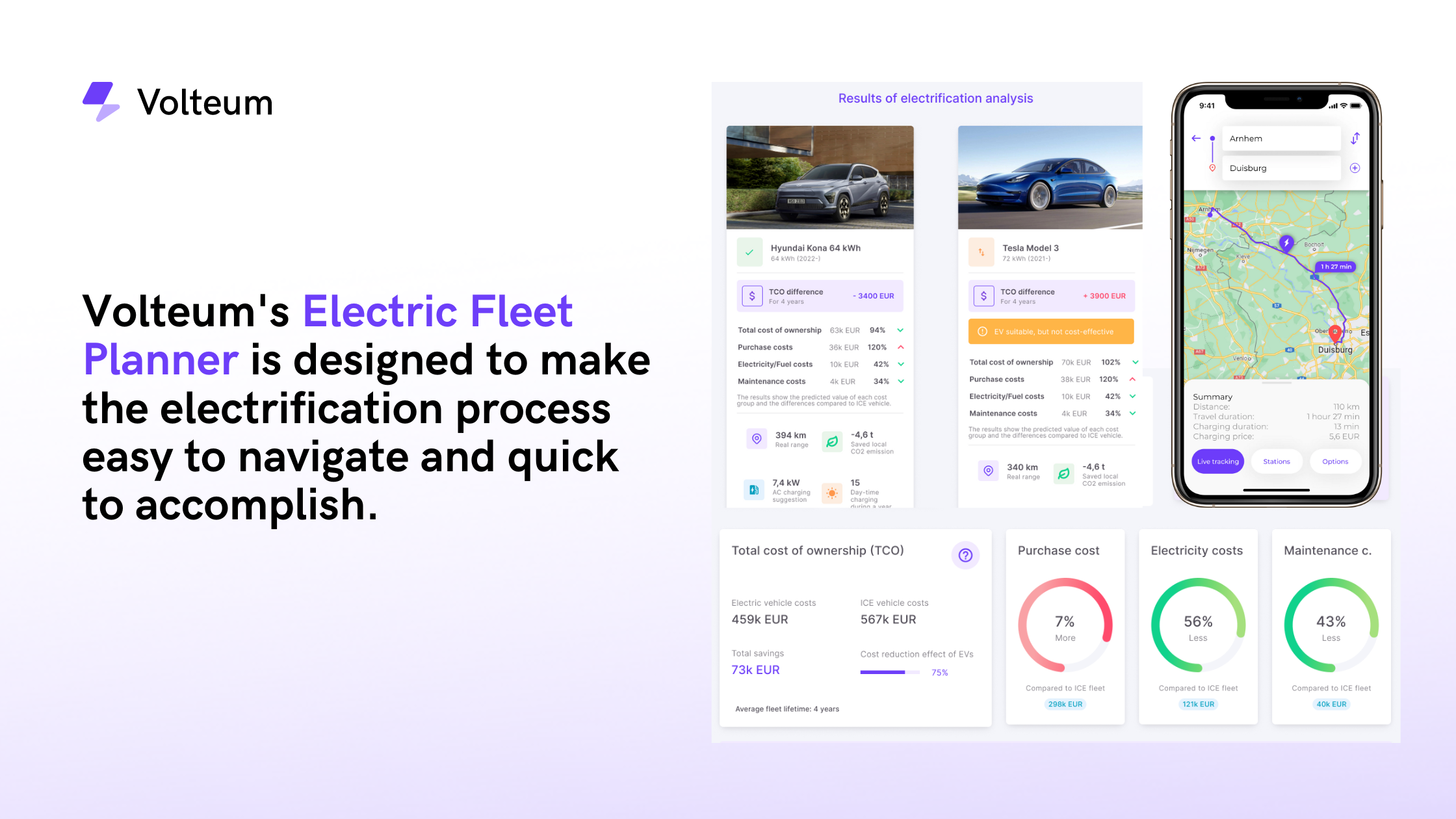In-house fleet electrification: Overcoming the challenges
Oct 05, 2023 · 10 min read · blog
As we stand on the precipice of a new era in transportation, the rapid growth and development of electric vehicles are reshaping global markets and presenting both opportunities and challenges for businesses. The race towards fleet electrification is on and has already started to make its mark on various industries. However, it is not without its struggles.

The global EV market trends are showing electrifying growth. According to the International Energy Agency, there will be nearly 125 million EVs on the road by 2030, up from just over 3 million in 2017. This exponential increase is driven by government policies promoting eco-friendly transportation, advancements in battery technology, and a growing societal awareness about the environmental impacts of fossil fuels.
Yet, as more companies look to incorporate EVs into their fleet, they are often confronted with a complex set of challenges. These range from the high upfront costs of EVs, limited driving range, to the lack of charging infrastructure. Moreover, managing a fleet of EVs is fundamentally different from managing traditional fleets. It requires careful planning and management to avoid operational disruptions and ensure optimal utilization.
This is where the value proposition of a data-based software solution for fleet electrification comes into play. By leveraging advanced analytics and machine learning algorithms, these solutions can help businesses overcome the challenges of fleet electrification. They provide actionable insights into when, where, and how to charge EVs, predict maintenance needs, and optimize routes to maximize efficiency.
In this blog post, we will delve deeper into the struggles of in-house electrification and explore how data-driven software solutions can help businesses navigate this electrifying transition.

The complexity of fleet electrification

Transitioning to an electric fleet is not merely about replacing gasoline-powered vehicles with electric ones. It involves a complex interplay of various factors that can significantly impact the success of the transition.
- Charging infrastructure: One of the main challenges is the development of charging infrastructure. Unlike refueling conventional vehicles, which takes just a few minutes at any gas station, charging an EV can take several hours. Moreover, charging stations are not as widely available as gas stations, especially in remote areas. This necessitates careful planning and investment in charging infrastructure to ensure that EVs are always ready to perform their duties.
- Vehicle selection: Vehicle selection is another critical aspect of fleet electrification. Not all EVs are created equal. They vary in terms of their range, charging speed, payload capacity, and price. Therefore, businesses need to carefully evaluate their needs and choose the right mix of vehicles that best meet their operational requirements while also being cost-effective.
- Incentives and grants: Incentives play a crucial role in offsetting the high upfront costs of EVs. Many governments offer tax credits, grants, and other incentives to encourage businesses to switch to EVs. However, navigating through these incentives and understanding how to maximize them can be a daunting task.
- Efficient operation: Operation optimization is essential for managing an electric fleet efficiently. This includes planning routes to minimize driving and charging time, scheduling maintenance to avoid disruptions, and managing energy consumption to reduce costs.
- Regulatory compliance: Lastly, compliance with regulations is a significant concern for businesses transitioning to EVs. As governments around the world tighten emission standards and introduce new regulations for EVs, businesses need to stay abreast of these changes and ensure their fleets comply with all relevant laws and regulations.
Indeed, the complexity of fleet electrification is immense. But with the right approach and tools, businesses can navigate through these challenges and successfully make the switch to an electric fleet.



Hidden costs of in-house electrification

Embarking on an in-house electrification project can seem like a cost-effective strategy at first glance. However, there are several hidden costs associated with managing such a project that businesses need to consider.
One of the most significant costs is related to infrastructure development. Building a network of charging stations involves not just the cost of the charging equipment but also the cost of installation, electrical upgrades, and ongoing maintenance. Additionally, businesses may need to invest in energy management systems to optimize power usage and prevent overloading their electrical grid.
Workforce training is another overlooked cost. Employees need to be trained on how to operate and maintain the new electric vehicles and charging equipment. This includes drivers, mechanics, fleet managers, and other staff involved in fleet operations. The cost of this training can add up quickly, especially for large fleets.
The opportunity cost of diverting resources away from core operations is another hidden expense. Managing an electrification project requires significant time and effort. This means less time spent on improving products or services, expanding into new markets, or pursuing other strategic initiatives.
Moreover, there can be unforeseen costs associated with regulatory compliance, insurance, and vehicle downtime due to maintenance or charging. These costs can quickly escalate, making the total cost of ownership of EVs higher than initially anticipated.
In essence, while the idea of in-house fleet electrification may seem attractive, it comes with numerous hidden costs. Businesses should therefore consider these factors carefully and evaluate whether partnering with an external provider might be a more cost-effective and efficient solution.



Considering the expertise gap

Effective fleet electrification requires a unique blend of knowledge and skills that many businesses may not possess in-house. This expertise gap can pose significant challenges and risks to the success of an electrification project.
- One of the critical areas of expertise is vehicle selection. This involves understanding the specific characteristics and performance of various electric vehicles and how they align with the company's fleet patterns and needs. It requires knowledge of battery technology, vehicle range, charging speed, payload capacity, and other technical aspects. Making the wrong choice can lead to operational inefficiencies and higher costs.
- Optimizing the charging infrastructure is another area that requires specialized knowledge. This involves determining the optimal number and location of charging stations, understanding peak demand times, and managing power usage to avoid overloading the electrical grid. It also requires familiarity with different types of charging equipment and their compatibility with various EV models.
- Regulatory compliance and reporting is a complex area that requires a deep understanding of emission standards, tax credits, grants, and other incentives related to EVs. Navigating through these regulations and ensuring compliance can be a daunting task without the right expertise.
- The challenge of filling this expertise gap is further compounded by the difficulty of recruiting and training experts in the field. The EV industry is relatively new, and there is a shortage of skilled professionals with experience in managing electric fleets. Moreover, training existing staff can be a time-consuming and costly process.
In conclusion, the expertise gap is a significant barrier to in-house fleet electrification. Businesses need to consider this carefully and evaluate whether seeking external expertise might be a more effective and efficient approach.

Alternative solution: Volteum's Electric Fleet Planner

In light of the challenges associated with in-house fleet electrification, an alternative solution is to leverage expert tools like Volteum's Electric Fleet Planner. This tool provides a comprehensive and customized approach to fleet electrification, addressing the various complexities and hidden costs associated with this transition.
One of the main advantages of using Volteum's Electric Fleet Planner is its ability to conduct a thorough fleet analysis. The tool identifies which vehicles are suitable for electrification, providing recommendations that ensure informed decision-making from the start. This eliminates the guesswork involved in vehicle selection and aligns with the specific needs and patterns of your fleet.
The software also excels in customizing EV model selections based on historical activities, range, total cost of ownership (TCO), and driver preferences. By prioritizing the criteria that matter most to your operations, Volteum delivers precise outcomes tailored specifically to your needs.
When it comes to charger selection, Volteum's Electric Fleet Planner determines the exact type and number of chargers needed for optimal operation. This insight eliminates uncertainty and costly mistakes, enabling a seamless charging infrastructure that meets the demands of your fleet.
In addition, Volteum provides detailed reports that highlight the financial and sustainability benefits of transitioning to electric vehicles. These reports offer precise figures and data, summarizing the potential savings and environmental impact of the electrification journey.
Comparing the total costs and advantages of both approaches, it's clear that Volteum's Electric Fleet Planner offers significant cost-efficiency and time-saving advantages. Not only does it eliminate the need for recruiting and training in-house experts, but it also allows businesses to focus their resources on core operations.
Volteum's user-friendly software solution is designed to make the electrification process easy to navigate and quick to accomplish. Its customizable data input ensures a seamless electrification process tailored to your fleet's unique requirements. With Volteum, you have the tools and support you need to make the transition to an electric fleet efficiently and effectively.



Conclusion

In-house fleet electrification, while seemingly an attractive option, is fraught with hidden costs and challenges. From infrastructure development and workforce training to the opportunity cost of diverting resources from core operations, businesses may find themselves facing significant hurdles. Not to mention, the expertise gap in areas like vehicle selection, charging infrastructure optimization, and regulatory compliance can pose significant risks.
Outsourcing to a data-based software solution like Volteum's Electric Fleet Planner offers a smarter, more cost-effective path to fleet electrification. It provides a comprehensive, customized approach that addresses the complexities and costs associated with this transition. Through thorough fleet analysis, customized EV selection, optimal charger selection, and detailed reporting, Volteum empowers businesses to make informed decisions that align with their specific needs and goals.
By leveraging expert tools and insights, companies can navigate the electrification process more efficiently and effectively, focusing their resources on core operations and driving their business forward. In the end, the journey towards a greener future need not be a daunting one, but rather a strategic and well-informed shift powered by intelligent solutions like Volteum's Electric Fleet Planner.
